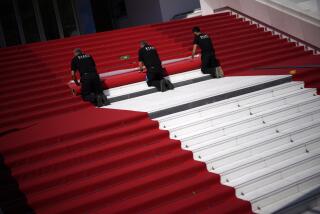American TV Is Alive and Well in Europe : Entertainment: U.S. firms flock to Cannes marketing festival despite all that talk of cultural roadblocks.
- Share via
CANNES, France — “Davide, Davide . . . Ici, ici s’il vous plait,” the photographers called out to veteran TV actor David Hasselhoff, who was sandwiched on a small stand in the bunker of the Palais des Festivals during the MIP-TV market.
The European press contingent’s hysteria over the “Baywatch” star was understandable. Though NBC dumped the series years ago, the strength of it in syndicated form in markets such as France, Germany and Britain has made Hasselhoff a European television and recording star.
On the basis of the series’ international success, he and All American Television came here to begin testing interest in a spinoff series tentatively called “Baywatch 2,” which is being watched by other U.S. producers as a barometer of the European market for sequels.
After all, this was the first Marche International de Programmes Television, or MIP-TV, to be held since the entertainment industry was excluded from the General Agreement on Tariffs and Trade accord. While some feared that the market for American products in Europe might dry up or at least diminish, people attending the festival said programs such as “Baywatch” remain as popular as ever.
“I am tired of all this crap about quotas and this GATT nonsense,” one executive said privately. “It’s all B.S., written by the trade press in Los Angeles. . . .”
MCA TV International President Colin Davis agreed, saying: “The Europeans are buying as much as they ever did. If you look at the figures for all the major American companies, international sales continue to grow each year.”
While most European TV viewers prefer home-grown products, American shows still make up 30% of European schedules, and Davis says that will continue as the number of stations grows.
Jim McNamara, president and CEO of New World International, concurs that quotas have had little effect on business at MIP, saying, “The bottom line is we come one-third or halfway around the world to sit in a tourist resort where we are never able to go outside; we spend our money on things like this (a key ring in the shape of a bloodied ax that lets out a scream) and on huge parties to get people’s attention, because there are somewhere between 2,000 and 4,000 buyers here, and despite GATT and despite the quotas, they come here to buy products.”
On average, big U.S. companies spend $200,000 to $400,000 on promotion, booths, travel and entertainment at MIP. But some studios can write between $10 million and $25 million in business. MIP is also seen as the perfect setting to conclude business begun by fax and phone.
“MIP is a bit like swallowing a small pill containing the entire international entertainment industry which sits in your stomach for six days,” said Drew Levin, president of DSL Productions.
MIP can be particularly trying for producers with more cerebral projects. British documentary producer Diarmuth Jeffreys from Connaught Films explained a pitch he made to a U.S. executive last week that could easily be a scene from “The Player”: “We give him this proposal on a Mother Theresa documentary, and we are quite reverent, as you are when presenting this idea for a program on a living saint. You know what his answer is?
“ ‘We don’t do nuns. Our male audience does not respond well to nuns.’ ”
Whatever the current taste, MIP remains an American market with more booths from America than any other country. The main source of tension is American programming on French TV--particularly after the recent U.S.-French battles over the import of American programs and services.
“France is still the market most affected by quotas,” Levin said. “If you want to work with France, it has to be a French production . . . “
One project announced between Turner Productions and the French pay TV channel Canal Plus, “The Native Americans,” shows how U.S. producers are finding ways to work around quotas, although many executives were scratching their heads over the partnering of a French company in a documentary series about Native Americans.
Other cultural differences also stand out.
While the Canal Plus booth is made of stark, white rice paper with small splashes of discreet color from its Canal Plus logo, the Paramount booth is a spaceship from “Star Trek,” complete with a bar hosted by staff dressed as Starship Enterprise crew members.
Perhaps therein lies l’invasion cultural that no quotas can ever reverse.
More to Read
The biggest entertainment stories
Get our big stories about Hollywood, film, television, music, arts, culture and more right in your inbox as soon as they publish.
You may occasionally receive promotional content from the Los Angeles Times.









